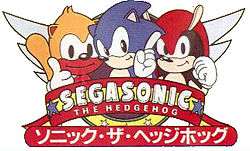SegaSonic the Hedgehog
| SegaSonic the Hedgehog | |
|---|---|
 | |
| Developer(s) | Sega-AM3 |
| Publisher(s) | Sega |
| Director(s) | Tomosuke Tsuda |
| Designer(s) |
Manabu Kusunoki Kiyoshi Miyagi Masahiro Hoshino Satoshi Yamagata |
| Programmer(s) |
Hideshi Kawatake Takashi Hasegawa Tetsuya Kawauchi |
| Composer(s) |
Hiroshi Kawaguchi Keitaro Hanada Naoki Tokiwa |
| Series | Sonic the Hedgehog |
| Platform(s) | Arcade |
| Release date(s) |
‹See Tfd› |
| Genre(s) | Platform |
| Mode(s) | Single-player, multiplayer |
| Cabinet | Upright |
| Arcade system | Sega System 32 |
| Sound |
2x YM3438 RF5C68 |
| Display |
Raster (horizontal), 320×224 resolution |
SegaSonic the Hedgehog (セガソニック・ザ・ヘッジホッグ SegaSonikku za Hejjihoggu) is an isometric platform game in the Sonic the Hedgehog series, released by Sega for arcades in 1993. The game supported three players playing simultaneously, and possessed a unique track ball set up for moving on-screen characters.[1] The only other control input was a single button, allowing the player to perform a jumping attack. The use of the trackball has subsequently led to great difficulty in emulation efforts, with Yuji Naka stating it as the reason for it not being included on future compilations or rereleases, such as Sonic Gems Collection.[2]
Gameplay

Gameplay in SegaSonic the Hedgehog has been likened to the game Marble Madness.[3] Up to three players can play as either Sonic the Hedgehog, Mighty the Armadillo or Ray the Flying Squirrel, as they are kidnapped by Doctor Robotnik and placed on an island filled with death traps that they must escape from. The game, played in an isometric perspective, is controlled using a trackball to control a character's direction and speed and a button used to make the character jump into a Spin Attack. Using these controls, players must try to make it to the end of each course whilst avoiding traps and staying ahead of the danger behind them. Each character has a life bar which goes down if the player falls into traps, with the player losing a life if the bar empties. Health can be recovered by collecting rings that are littered around the course or hidden inside obstacles or enemies. A bonus is awarded if the player collects over a certain percentage of rings within a level.
Legacy
Mighty would later appear as a playable character for the Sega 32X game, Knuckles Chaotix.[4] Ray never appeared in any subsequent games, but he and Mighty would both be featured in the Sonic the Hedgehog comic series from Archie Comics. Ray would become a member of the Chaotix along with Mighty, who is depicted in the series as his honorary brother.
In Sonic Generations, there is a in-game poster that can be found in both acts of the City Escape stage that features images of Ray and Mighty.
References
- ↑ Mcwhertor, Michael (22 Apr 2006). "Sonic The Hedgehog Arcade From Start To Finish". Kotaku. Gawker. Retrieved 28 May 2012.
[The game] was a three-player, trackball-controlled affair.
- ↑ Kemps, Heidi (30 Sep 2005). "GameSpy Xbox: Sega's Yuji Naka Talks! - Page 2". GameSpy. Internet Archive. IGN Entertainment. p. 2. Archived from the original on 19 Feb 2006. Retrieved 28 May 2012.
Yuji Naka: It was done by part of the Sega arcade division at the time. We did think about adding it to Gems Collection, though, but we couldn't implement it in the end because the game used a trackball control scheme that is very, very difficult to replicate with a standard controller.
- ↑ "Sonic The Hedgehog Arcade - Videogame by Sega of Japan". The International Arcade Museum (in English and Japanese). Killer List of Video Games. 1995–2012. Retrieved 28 May 2012.
The game play is somewhat similar to Marble Madness.
- ↑ Various. "Knuckles' Chaotix (Video Game)". Giant Bomb. Giant Bomb. Retrieved 28 May 2012.